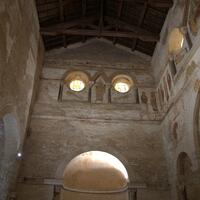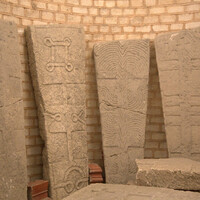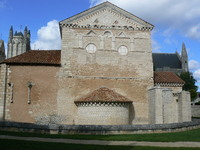Poitiers Baptistery
Type:
Baptismal fonts,
Baptisteries,
Capitals,
Sarcophagi
Date:
Fourth to seventh centuries, with later renovations; frescoes early twelfth century
Location or Findspot (Modern-Day Country):
France
Medium:
Stone,
Terra-cotta
Description:
There were Christians in Poitiers by the fourth century, and the town produced two early medieval saints. Bishop Hilary (d. ca. 367) was active against the Arian heresy, and the Merovingian (Frankish) queen Radegunde (d. 587) founded the Holy Cross Monastery in Poitiers after receiving a relic of the True Cross from the Byzantine emperor Justin II. It was near Poitiers in 732 that the Franks stopped the Umayyad attempt to expand from the Iberian Peninsula into Europe.
The baptistery at Poitiers is the best-preserved building from early medieval France. It is dedicated, like most baptisteries, to St. John the Baptist. The original baptistery was a long rectangular hall with an octagonal font as its focus, large enough for adult immersion. In the late seventh century that space was divided into two rectangular rooms, and by about 1000 square apses were added on the north and south sides and the east apse was extended (the apses were remodeled in the nineteenth century to their current semicircular form). The baptistery's exterior is noteworthy for its decorative treatment: pilasters with schematic capitals, miniature pediments, sculpted plaques, and colorful terra-cotta enliven the masonry. On the interior the columns are Roman spoil, but their high-quality capitals were carved in the Pyrenees about 700. The fragmentary Christological frescoes date to about 1100, perhaps when the building became a parish church. The baptistery now displays numerous Merovingian sarcophagi, many with ornately carved lids; these are datable between the fifth and eighth centuries. Even though these funerary works were not part of the medieval baptistery, they are reminders that Christians consider baptism both an imitation of Jesus's own baptism and a symbolic death and rebirth in Christ.
The baptistery at Poitiers is the best-preserved building from early medieval France. It is dedicated, like most baptisteries, to St. John the Baptist. The original baptistery was a long rectangular hall with an octagonal font as its focus, large enough for adult immersion. In the late seventh century that space was divided into two rectangular rooms, and by about 1000 square apses were added on the north and south sides and the east apse was extended (the apses were remodeled in the nineteenth century to their current semicircular form). The baptistery's exterior is noteworthy for its decorative treatment: pilasters with schematic capitals, miniature pediments, sculpted plaques, and colorful terra-cotta enliven the masonry. On the interior the columns are Roman spoil, but their high-quality capitals were carved in the Pyrenees about 700. The fragmentary Christological frescoes date to about 1100, perhaps when the building became a parish church. The baptistery now displays numerous Merovingian sarcophagi, many with ornately carved lids; these are datable between the fifth and eighth centuries. Even though these funerary works were not part of the medieval baptistery, they are reminders that Christians consider baptism both an imitation of Jesus's own baptism and a symbolic death and rebirth in Christ.
Relevant Textbook Chapter(s):
2,
3
Image Credits:
Wikimedia, Linda Safran







